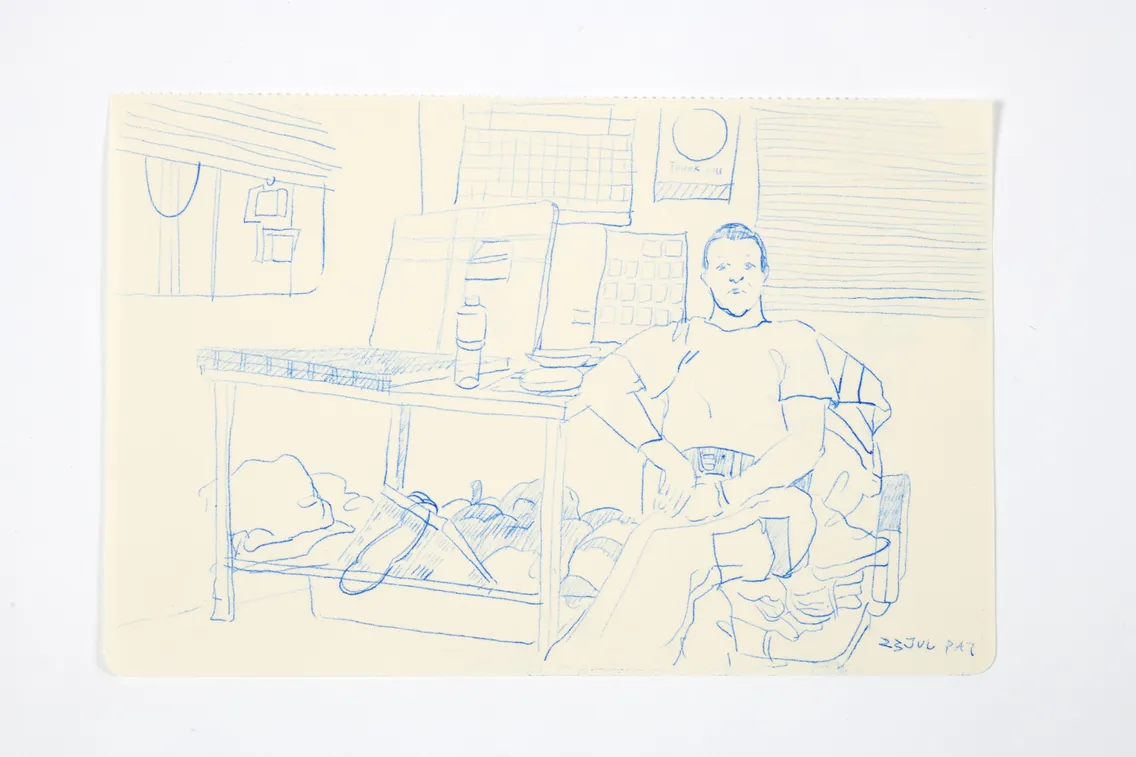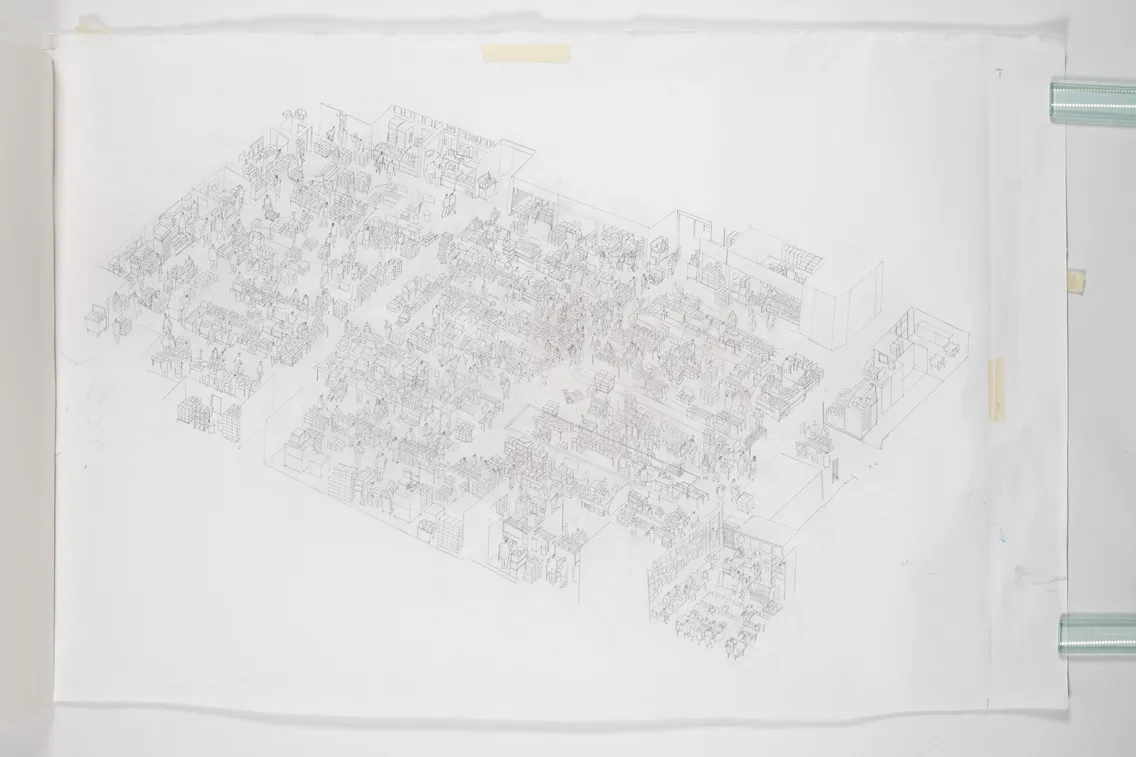04 January 2024 — By Pat Wingshan Wong, Thomas Ardill
Bartering at Billingsgate Fish Market
Ahead of their move to Dagenham, the fishmongers of Billingsgate Market have many stories to tell. Artist Pat Wingshan Wong creates an archive of their memories, with a unique method of gaining their trust.

A view above the busy trading floor at Billingsgate Market. This is one of many photographs Bob Collins made there in 1958.
Billingsgate Market dates back to the 1300s, if not before, when a general market was operating in the ward of Billingsgate between London Bridge and the Tower of London. It became a fish market in the 1700s, and a purpose-built market building was constructed in 1850, and rebuilt in 1877. The market moved to a new building in Poplar, near Canary Wharf, in 1982. While London Museum has a strong collection relating to the old fish market on the Thames, the current market building has been less well documented. With the City of London Corporation’s 2019 announcement of a plan to relocate the market to Dagenham Dock, the museum was keen to capture the experiences of the Billingsgate Market’s community before they made the move.
“The Barter Archive: Drawings in exchange for stories and meaningful objects”
In stepped Pat Wingshan Wong: an illustrator and artist, who in 2019 began an art project at Billingsgate as part of her Master’s degree in illustration at the Royal College of Art. Wong began by sketching life at the market, arriving each day at 5am to stand in the cold and draw the activity around her. Slowly, the fishmongers, porters, ice suppliers, café staff and customers began to take an interest. Wong got to know the community by chatting to them and showing them her drawings. Even giving some away as gifts. As she gained their friendship and trust, Wong began to develop a new methodology of community working based on swapping, or ‘bartering’, her drawings in exchange for their stories and meaningful objects representing their memories and experiences of working in the market. The Barter Archive was born.
In 2021, London Museum commissioned Wong to use her barter method to collect a series of stories from the Billingsgate Market community. This was part of the museum’s London Eats project. Wong collected oral history interviews and personal objects that the traders either donated or lent for her to scan and turn into digital models and 3D-printed ceramics. Wong gave them drawings in exchange, using carbon copy paper so that she could retain facsimile drawings as a form of receipt. She also drew a birds-eye map of the market, plotting the workplaces of the people she bartered with, which she overlaid with icons representing the bartered objects. The map acts as a key, drawing together the people, objects and memories of the market. These objects, now in the museum’s collection, ensures that as Billingsgate enters the next chapter of its 700-plus-year history, its tenure at Poplar would not be forgotten.
Here, Pat Wingshan Wong talks about the project and her inspiration.
What inspired the Billingsgate Memory Project?
This similar narrative of displacement between the Billingsgate Fish Market and the market in Hong Kong was one of many factors that drew me to Billingsgate. As I grew up [in Hong Kong without a garden], one of our favourite places is the street market in Mong Kok and Sham Shui Po. [W]e did a lot of bargains to ask for a cheaper price. Both vendors and customers bargain with jokes. You never feel offence in the bargaining, and both sides are always satisfied with the result.
The Barter idea employs this experience in the Billingsgate Fish Market. I use my drawings to ‘barter’ [or] exchange with the fishmonger’s memorable [objects]. Through this exchange, I created a dialogue with the fishmongers to understand the living and community relations in the market.
In 2019, I just sketched, then gave back the drawing as a gift to the fishmongers. Most of them took [the drawings] back home, and some put [them] in the office. I saw one was framed in the shop front. Some fishmongers told me their fathers were so pleased to see the drawings, as some of them started the business and their sons inherited them.
The Barter Archive idea came up in 2020. I still remember Ali, the cafe owner, said he would back me up with whatever I needed help with, so his café became the first physical exhibition place. Most of the [fishmongers] finally understood the project when I had my first exhibition ‘Barter Outlet’ inside the Billingsgate Fish Market. They saw their sketches hanging on the wall, and I could see their happiness when watching the video and finding themselves in the drawings.
Being an artist from HK, interacting with people from different ethnicities at the market, could you share some of your experiences of working with the fishmongers?
Communication with the fishmonger takes time, with the language [barrier], and I am [not] looking for a one-off conversation to listen to their story. I am more interested in their habits, behaviour and [in] building honest and transparent relationships. I remember I spent three months bartering the shark skull from JP & L Exotics Ltd. Paul, the son of the shop owner, had to ask his father to agree to let me barter the skull for the 3D scanning, and whenever I saw him he would [make an] excuse and leave. The long-term negotiation let him understand my intention, and I think this process become a testing ground to embody our mutual trust in barter-exchanging our memory. I [don’t] only ask and take, I also give the sketch and my story to them equally. They see how others react to my presence and the bartering. For example, Mark gave me his favourite lobster necklace because Laurie gave me his porter badge. So, repetition is important.
“Mark gave me his favourite lobster necklace because Laurie gave me his porter badge”
What objects make up the Barter Archive?
The archive is constructed with 3D scanned objects, interview videos, photographs, text and sketches. Using the 3D scan to create 3D-printed ceramic is one of the ways to use the archive materials. The 3D scan ceramics are made of porcelain, and the materials, which are fragile, smooth and glossy, have a great contrast with the original objects, [which] are practical and durable. To use the term from the art market, the ceramics, signed by the fishmongers, [are] an artist's proof. When we question how value is defined, the complex layers of the art market, consumerism, and city development are all involved in the topic and the exhibition.
Are there any stories that have stood out for you?
I met a fishmonger who used to be a banker in central London. He prefers to work here as the fish market has fewer politics and more trust. I met Bobby in Bobby’s Fish. He spent almost his whole life in the market, and although he is 74 years old, he enjoys the time when he works here with his son and grandson.
How do you think the planned move to Dagenham impacted the stories you collected?
It will become a memory book for the fishmongers; I would like to continue expanding the project to include more voices. Some of the fishmongers will retire after the relocation. For those who will move to the new market, the atmosphere and bonding of the community will change. I remember Laurie’s interview and how frustrated he [was] about the [plan to] demolish not only the physical building, but also the culture and value of the people.
Why make this map of Billingsgate Market?
I did a map to mark down the location[s] where I sketched for practical use. I want to ensure the record is comprehensive. Then, I [thought] about expanding the idea to make a barter map. The map references the sketch I did in the market, employing the idea from psychogeography. I especially want to highlight the people’s activity on the map, for example, inside the map Big Greg is walking with the trolley, Richard is eating his breakfast, Bobby’s family is standing inside their shop selling, etc. The map combines more than 70 sketches with my memories of over three years in the market.
What’s next for this project? And what inspiration are you taking from Barter Archive into your future work?
I want to take the initiative, share the experience and bring multi-discipline practitioners to join the project. I plan to create a residency project.
My experience from Hong Kong influenced the Barter Archive project, and my experience in illustration research, influenced my current project in Hong Kong, as I went back to Hong Kong [in 2022], and became the Assistant Professor at the [Academy of Visual Art, Hong Kong Baptist] University. My upcoming project will continue to be related to city-land use. It is a project that aims to explore the ways in which land developers and audiences are complicit in the marginalisation of a community’s memories. The exhibition will expand the idea of the Barter Auction by creating an ironic, humorous criticism of the unbalance land resource allocation and hegemony of the property development in Hong Kong.
Thomas Ardill is Curator of Paintings, Prints and Drawings, at London Museum.
Pat Wingshan Wong’s art series was part of the London Eats theme under the museum’s Curating London collection programme. This project aimed to understand and reflect upon Londoners’ relationship with food and drink. One of our collecting themes was ‘Places and Spaces’, and visitors told us that the places they were most interested in were food markets, and that’s how the Barter Archive for the Billingsgate Fish Market came about.










